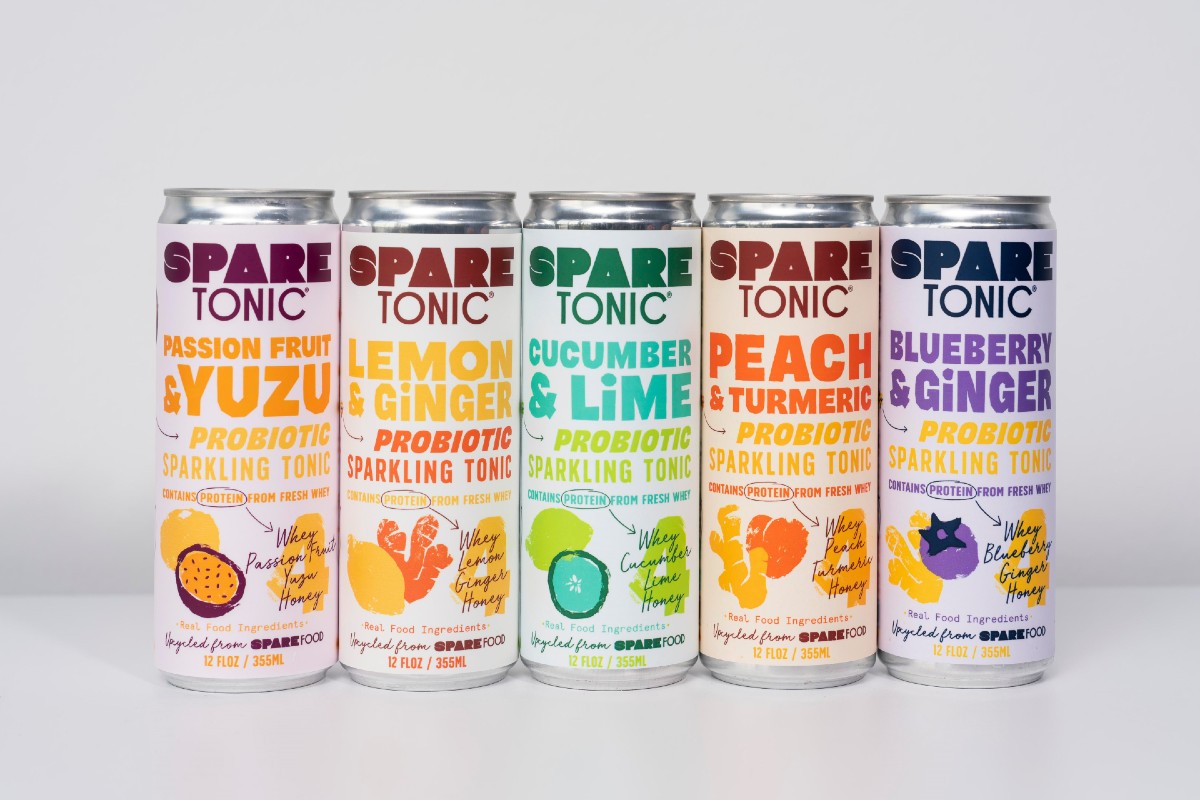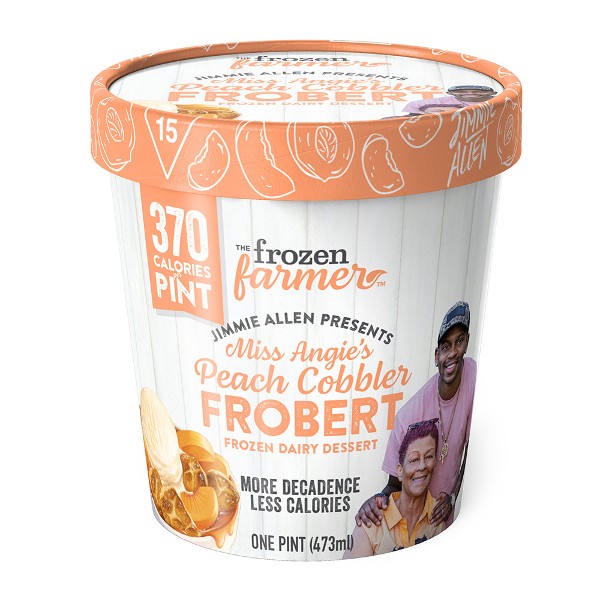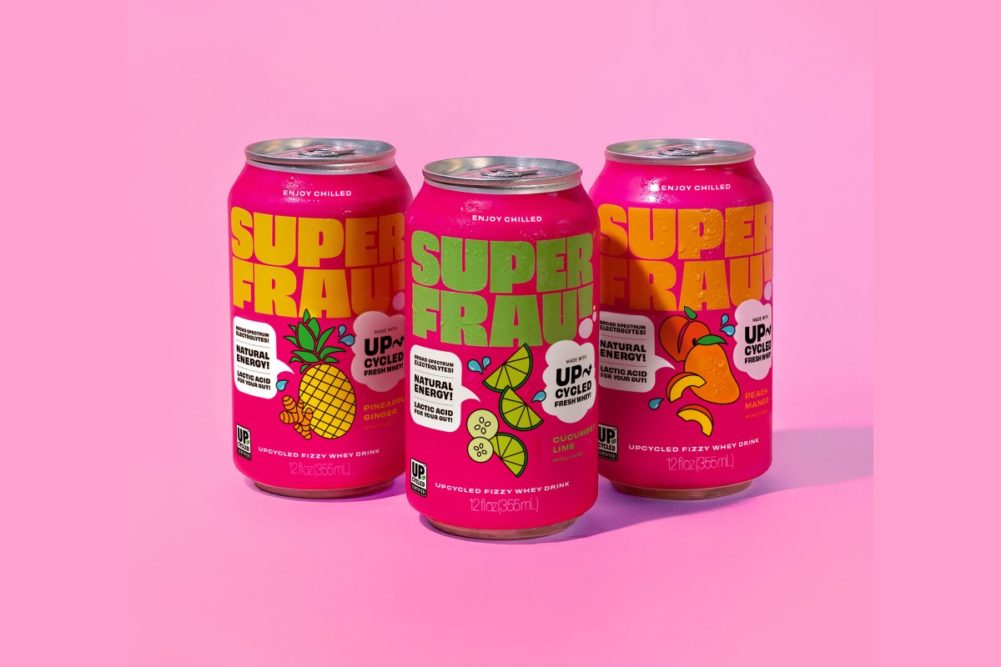Cheesemakers have been producing upcycled ingredients – namely in the form of dried whey – since before upcycling was even a coined term.
Butter manufacturers, too, as true buttermilk is the liquid that remains after whole milk has been churned into butter. Upcycling is all about preventing healthful, nutritious foods and food ingredients from becoming waste by giving them a second chance to be consumed.
To assist in this effort, social activists Ben Gray and Turner Wyatt founded the Upcycled Foods Association (UFA), Denver, and officially defined the term “upcycled food” in 2020 for use in policy, research and more. The team of consulting experts agreed that “upcycled foods use ingredients that otherwise would not have gone to human consumption, are procured and produced using verifiable supply chains and have a positive impact on the environment.” Since then, UFA has enlisted as many as 230 members worldwide and says it has diverted an estimated 840 million pounds of food waste from landfills. Along the way, it created a third-party validation process and has officially certified 236 upcycled food products and ingredients.
Communicating efforts
Upcycling has been going on in the food and ingredient space for a long time, but without the recognition it is getting today as a result of growing consumer interest in reducing food waste through a circular economy. Processors and marketers are now quantifying their production or use of upcycled ingredients and making this part of the product’s selling points.
Innova Market Insights, The Netherlands, has tracked consumer sentiment towards foods made with upcycled ingredients for several years. In 2022, the research firm reported that more than a third of consumers found upcycled products to be more appealing than other products. This was up from a quarter the previous year and aligns with consumers’ growing interest in sustainability.
“This overall trend provides manufacturers with opportunities for storytelling,” said Lu Ann Williams, global insights director at Innova Market Insights. “According to our database of global food and beverage launches, North American food and beverage launches with a food waste and/or upcycling claim experienced 52% average annual growth between 2017 and 2021.”
While turning the byproduct of cheesemaking, known as sweet whey, into high-protein ingredients rather than feeding it to farm animals is smart business, it’s not that dynamic of a story. It’s all the other ingredients that are now being upcycled that is catching the attention of the sustainability-conscious shopper. This includes the acid whey stream created during strained yogurt production, something that only came into abundance when authentic Greek yogurt entered the US marketplace about 15 years ago.
For every one cup of strained yogurt produced, two to three cups of acid whey are created. Its low pH prevents it from being converted into a high-protein ingredient like cheese whey. Instead, it is usually neutralized and discarded. That’s tens of thousands of gallons of whey being sent to landfills or water treatment facilities.
 Photo: The Spare Food Company
Photo: The Spare Food Company"That’s billions of probiotics and other nutrients that could be used to fuel humans in our community instead of being wasted,” said Adam Kaye, co-founder, The Spare Food Co., New York, and a member of UFA. “We take an unused ingredient and craft it into a delicious food. In the process, we eliminate climate-destructive waste, support a regional food system of farmers, producers and vendors, and bring a healthful product to market.”
That product is Spare Tonic, a shelf-stable effervescent drink that contains 85% to 90% upcycled whey purchased from local yogurt makers. It is made with only three other ingredients: fruit, spice and a touch of honey added as the fermentation catalyst.
“This refreshing take on an ancient elixir naturally provides a good source of protein, is rich in electrolytes, including calcium, magnesium and potassium, and is an excellent source of vitamins B-12 and B-6,” said Jeremy Kaye, co-founder and brother to Adam. “It has a natural 3:1 carbohydrate to protein ratio, which makes it ideal as a post-workout recovery beverage.”
Other UFA members are also being creative with whey. Superfrau, Dorchester, Mass., for example, rescues the surplus liquid whey from its yogurt-manufacturing partners in New York and Pennsylvania, then infuses it with natural flavors and adds carbonation. The formulation includes lactase to make the beverage lactose free. The lactase breaks down the disaccharide lactose into two much-sweeter monosaccharides glucose and galactose – eliminating the need to add any sweetener.
 Photo: Wheyward Spirit
Photo: Wheyward SpiritFor the over-21 crowd, Wheyward Spirit, Portland, Ore., repurposes whey to make this new spirit, which can be consumed in the same manner as vodka. During the fermentation process, yeast converts the lactose from whey into alcohol. This product is then distilled. No lactose remains in the final product so it is completely lactose-free. The spirit highlights whey’s naturally delicate and creamy characteristics and has a signature flavor of oaky vanilla cream and warm spice notes, rounded by a subtle pear aroma. Every bottle of Wheyward Spirit diverts food waste, adds value to local food chains and generates a lower carbon and water footprint than traditional grain-based spirits, according to Emily Darchuk, founder and CEO.
Anand Rao, vice president, ingredients innovation, Agropur Ingredients, said that historically upcycling (in the form of drying) of whey was driven by the desire to capture the nutritional value of protein and lactose. But that’s changing, and advanced technologies are allowing for new uses for whey and the development of specialty whey ingredients for functional food innovation.
“With changing consumer attitudes and concerns about the environment, it is time for dairy ingredient suppliers and dairy foods manufacturers to talk about the positive impact of these long-existing upcycling efforts,” Rao said. “Our upcycling technologies include ion-exchange chromatography for isolation of individual proteins from whey.
“Purified whey protein ingredients are used in dairy-based dips for their emulsification properties,” Rao said. “Our upcycled refined lactose from cheese whey finds a nutritional role in ice cream, while lactose-rich products, such as permeate, are used to enhance the solids and provide richness in fluid milks, ice cream, cheese powders and yogurts.”
Permeate is a double upcycled ingredient. It’s the byproduct of whey protein manufacturing.
“Whey permeate powders contain milk minerals, lactose and small amounts of protein,” Rao said. “The mineral profile helps in flavor modulation, allowing dips and sauces to reduce added salt.”
Toolbox of ingredients
There are varied upcycled ingredients available for dairy processors to incorporate into formulations and add to their circle economy story. Many have been around forever and are already currently being used. Pectin is one such example.
“Pectin is made from the byproducts of juice production, citrus peels and apple pomace,” said Christine Addington, principal technical account manager-dairy, Cargill, Minneapolis. “Rather than discard these leftovers, Cargill relies on them to produce pectin, a time-tested ingredient known for its thickening, gelling and protein stabilization properties.
“Our newest pectin production plant, located in Bebedouro, Brazil, further supports our commitment to source ingredients sustainability. It is located in close proximity to citrus suppliers and their Rainforest Alliance-certified farms, which helps minimize carbon dioxide emissions from raw material transport and promotes regenerative agriculture practices,” Addington said. “Taking sustainability one step further, the Bebedouro plant is powered by thermal energy generated from biomass and biogas.”
Pectins have numerous applications in dairy products. High-methoxyl (HM) pectins, for example, make acidified dairy beverages possible.
“Left unprotected in acidic conditions, dairy proteins will stick together, forming large, unappealing clumps,” Addington said. “HM pectins form a protective ‘net’ around the proteins, preventing them from aggregating together.
“Low-methoxyl pectins have a role to play in dairy, too,” Addington said. “They’re used in dairy and plant-based yogurts, where pectin helps maintain decadent textures and mouthfeel, stabilizes proteins and prevents syneresis. They also provide a creamy texture to yogurt fruit preparations.”
Many fiber ingredients are byproducts from the production of other ingredients, such as natural color extracts from fruits and vegetables. FutureCeuticals, Momence, Ill., now offers a functional ingredient that contains 50% soluble and insoluble dietary fiber from upcycled apples, carrots, blueberries, cranberries and spinach. The ingredient delivers plant-based, intact dietary fiber and polyphenols to the gut. The fiber-bound polyphenols, once inside the gut, are released slowly and act as antioxidants to promote gut health.
The company also offers an ingredient made from the cascara, or skin of the coffee fruit. Historically cascara has been the waste stream of the coffee production process. When the cascara is discarded, it decomposes and creates harmful mycotoxins that are released into the environment. FutureCeuticals created a sustainable solution that preserves the cascara and repurposes it as a superfood for functional foods and beverages.
Chinova Bioworks, Fredericton, New Brunswick, Canada, upcycles the stems of white button mushrooms into a natural preservative that may be added to dairy products. The ingredient has broad-spectrum protection and is effective at inhibiting growth of bacteria, yeast and mold.
“It can meet the highest standards of natural preservation without compromising the flavor profile, texture or appearance of the food,” said Natasha Dhayagude, co-founder and CEO. “We work with mushroom farmers to harvest the wasted stems and upcycle them into a commercially viable ingredient. The process is similar to how most plant fibers are naturally extracted. It involves drying the mushrooms, grinding them and then using heat and water to purify the fiber from the stems. The minimal and eco-friendly processing helps deliver a natural mushroom fiber that improves the finished product’s quality, freshness and shelf life.”
The added bonus is that mushrooms require little water to cultivate. They have a short life cycle and are grown throughout the year, which leads to a sustainable supply source.
Cabosse Naturals, a brand from global chocolate giant Barry Callebaut, Brussels, upcycles the cacaofruit not used in the manufacture of chocolate. Only the beans/seeds are used to make chocolate, and this is only 30% of the cacaofruit. Cabosse has identified technology to upcycle the 70% side stream into cacaofruit pulp, juice and concentrates that may be used in food applications. For example, the zesty, fruity profile complements ready-to-drink coffee and tea beverages. Its honey-like taste goes well in sweet products, including ice cream, where the golden brown color of the cacaofruit ingredient also adds visual depth and richness.
Upcycled “ugly” fruit, as well as side streams from fruit processing and juice manufacturing, have application in dairy foods. FruitSmart Inc., Prosser, Wash., for example, offers a range of upcycled fruit fibers, powders and oils. The process begins at the company’s not-from-concentrate juice facility, where apples, blueberries, cranberries, etc., get crushed.
“Once the juice has been captured, we take the remaining pomace (the skins, pulp and seeds), dry it and then mill it,” said Wayne Lutomski, president. “That pomace would go to a landfill or for animal feed previously. Now it is used for human consumption in a beneficial way.”
 Photo: The Frozen Farmer
Photo: The Frozen Farmer
Adding fruits
Danone North America, White Plains, NY, now offers Two Good “Good Save” Greek yogurt. The company uses surplus produce or rejected fruit deemed too ugly for store shelves to make its Meyer lemon and pumpkin varieties. Cups communicate that the fruit in the product would have otherwise been wasted, helping consumers better understand the significance of their food choices in terms of environmental footprint.
Shark Tank-backed The Frozen Farmer, Bridgeville, Del., is a made-from-scratch frozen desserts company that came to fruition by third-generation family farmers Kevin and Katey Evans. The Evans family has been growing produce for local retailers for years and was frustrated with all the product that does not meet the grocery grade because of how it looks.
“More than 20% of the fruits and veggies in America are too ugly to make it off the farm and on the grocery store shelf. For farm families like mine, this means a major loss in profit,” Katey Evans said. “Finally, one night we were kicking around ideas of how to make money on all this otherwise wasted fruit that tasted perfectly good, despite the way it looked, and it came to us. We could make ice cream and sorbet with fresh fruit from the farm.”
For more than three years, the company has been producing super-premium frozen desserts using this fruit, including Frobert. This is the Evans’ signature blend of sorbet and frozen dairy dessert that has all of the delicious taste of traditional ice cream but with fewer calories, fat and sugar, according to Katey Evans.
The company recently partnered with country music star Jimmie Allen to create a Kroger-exclusive offering – Miss Angie’s Peach Cobbler Frobert – a nod to his mother (Miss Angie) and her peach cobbler.
Kroger, Cincinnati, is focused on reducing climate impact by reducing food waste, and the nationwide grocer is committed to achieving zero food waste company-wide by 2025. The company has embedded retail best practices to extend freshness and reduce waste in its operations since 2017, and The Frozen Farmer’s sustainability mission supports the grocer’s corporate initiatives.
“We are proud to collaborate with The Frozen Farmer as we work together to bring fresh, local, high-quality and inspiring flavors to our customers in a sustainable way,” said Barry Craft, vice president of fresh merchandising.
Lutomski said, “Upcycling is currently all the rage in the food and beverage industry. However, brands are still struggling with how to properly use upcycled ingredients in their product. Suppliers of upcycled ingredients will need to step up production before use can become widespread. If that can be done, and as long as there is some type of health and wellness functional benefit or a manufacturing benefit, the sky is the limit for upcycled ingredients. Gen Z will be the key driver on this front.”

